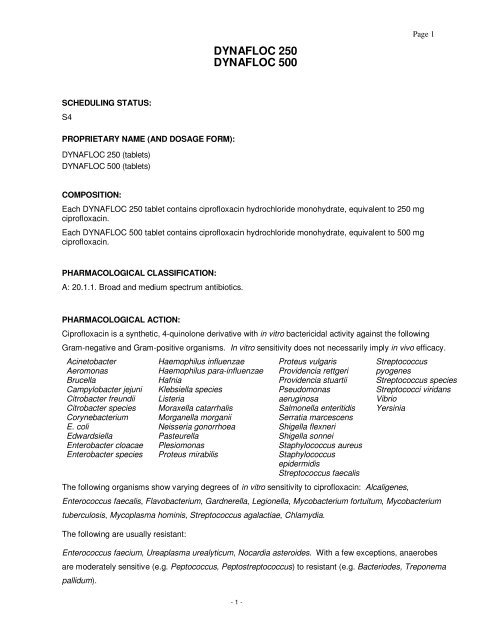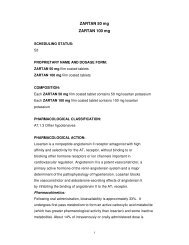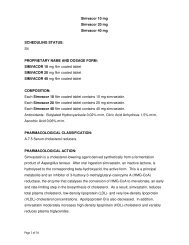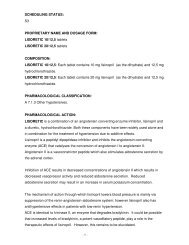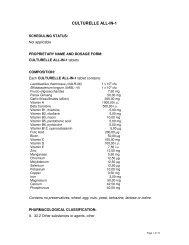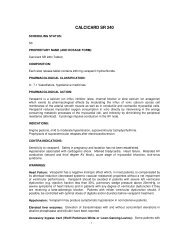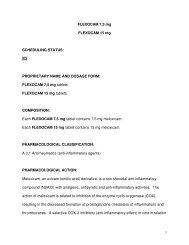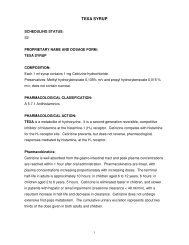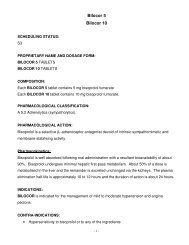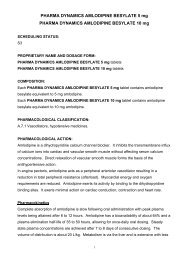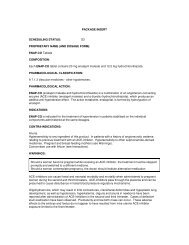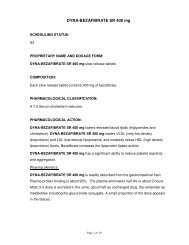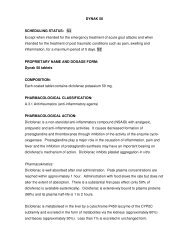DYNAFLOC 250 DYNAFLOC 500 - Pharma Dynamics
DYNAFLOC 250 DYNAFLOC 500 - Pharma Dynamics
DYNAFLOC 250 DYNAFLOC 500 - Pharma Dynamics
You also want an ePaper? Increase the reach of your titles
YUMPU automatically turns print PDFs into web optimized ePapers that Google loves.
SCHEDULING STATUS:<br />
S4<br />
PROPRIETARY NAME (AND DOSAGE FORM):<br />
<strong>DYNAFLOC</strong> <strong>250</strong> (tablets)<br />
<strong>DYNAFLOC</strong> <strong>500</strong> (tablets)<br />
COMPOSITION:<br />
<strong>DYNAFLOC</strong> <strong>250</strong><br />
<strong>DYNAFLOC</strong> <strong>500</strong><br />
Each <strong>DYNAFLOC</strong> <strong>250</strong> tablet contains ciprofloxacin hydrochloride monohydrate, equivalent to <strong>250</strong> mg<br />
ciprofloxacin.<br />
Each <strong>DYNAFLOC</strong> <strong>500</strong> tablet contains ciprofloxacin hydrochloride monohydrate, equivalent to <strong>500</strong> mg<br />
ciprofloxacin.<br />
PHARMACOLOGICAL CLASSIFICATION:<br />
A: 20.1.1. Broad and medium spectrum antibiotics.<br />
PHARMACOLOGICAL ACTION:<br />
Ciprofloxacin is a synthetic, 4-quinolone derivative with in vitro bactericidal activity against the following<br />
- 1 -<br />
Page 1<br />
Gram-negative and Gram-positive organisms. In vitro sensitivity does not necessarily imply in vivo efficacy.<br />
Acinetobacter<br />
Aeromonas<br />
Brucella<br />
Campylobacter jejuni<br />
Citrobacter freundii<br />
Citrobacter species<br />
Corynebacterium<br />
E. coli<br />
Edwardsiella<br />
Enterobacter cloacae<br />
Enterobacter species<br />
Haemophilus influenzae<br />
Haemophilus para-influenzae<br />
Hafnia<br />
Klebsiella species<br />
Listeria<br />
Moraxella catarrhalis<br />
Morganella morganii<br />
Neisseria gonorrhoea<br />
Pasteurella<br />
Plesiomonas<br />
Proteus mirabilis<br />
Proteus vulgaris<br />
Providencia rettgeri<br />
Providencia stuartii<br />
Pseudomonas<br />
aeruginosa<br />
Salmonella enteritidis<br />
Serratia marcescens<br />
Shigella flexneri<br />
Shigella sonnei<br />
Staphylococcus aureus<br />
Staphylococcus<br />
epidermidis<br />
Streptococcus faecalis<br />
The following organisms show varying degrees of in vitro sensitivity to ciprofloxacin: Alcaligenes,<br />
Streptococcus<br />
pyogenes<br />
Streptococcus species<br />
Streptococci viridans<br />
Vibrio<br />
Yersinia<br />
Enterococcus faecalis, Flavobacterium, Gardnerella, Legionella, Mycobacterium fortuitum, Mycobacterium<br />
tuberculosis, Mycoplasma hominis, Streptococcus agalactiae, Chlamydia.<br />
The following are usually resistant:<br />
Enterococcus faecium, Ureaplasma urealyticum, Nocardia asteroides. With a few exceptions, anaerobes<br />
are moderately sensitive (e.g. Peptococcus, Peptostreptococcus) to resistant (e.g. Bacteriodes, Treponema<br />
pallidum).
- 2 -<br />
Page 2<br />
Ciprofloxacin plasma levels are dose-related and peak 0,5 – 2 hours after oral dosing. The absolute oral<br />
bioavailability is approximately 70% with no substantial loss by first pass metabolism. Distribution of<br />
ciprofloxacin is wide and the volume of distribution high, indicating extensive tissue penetration.<br />
Ciprofloxacin is present in lung, skin, fat, muscle, cartilage and bone. It is also present in active form in the<br />
saliva, nasal and bronchial secretions, sputum, skin blister fluid, lymph, peritoneal fluid, bile secretions,<br />
prostatic secretions, cerebrospinal fluid and the aqueous humor. Protein binding is low. 40% to 50% is<br />
excreted in urine as unchanged drug. Approximately 15% of a single dose of ciprofloxacin is eliminated as<br />
metabolites. Elimination occurs primarily by the kidneys and mainly during the first 12 hours after dosing.<br />
Renal clearance is approximately 300 ml/minute. The elimination half-life of unchanged ciprofloxacin is 3 –<br />
5 hours. The elimination kinetics are linear; after repeated dosing at 12 hourly intervals and once steady<br />
state has been reached no accumulation occurs.<br />
INDICATIONS:<br />
<strong>DYNAFLOC</strong> is indicated for the treatment of the following infections caused by ciprofloxacin sensitive<br />
bacteria:<br />
Lower Respiratory Tract Infections caused by Escherichia coli, Klebsiella pneumoniae, Enterobacter<br />
cloacae, Proteus mirabilis, Pseudomonas aeruginosa, Haemophilus influenzae and Haemophilus para-<br />
influenzae.<br />
Urinary Tract Infections caused by Escherichia coli, Klebsiella pneumoniae, Enterobacter cloacae,<br />
Serratia marcescens, Proteus mirabilis, Providencia rettgeri, Morganella morganii, Citrobacter diversus,<br />
Citrobacter freundii, Pseudomonas aeruginosa, Staphylococcus epidermidis and Streptococcus faecalis.<br />
Skin and Soft Tissue Infections caused by Escherichia coli, Klebsiella pneumoniae, Enterobacter cloacae,<br />
Proteus mirabilis, Proteus vulgaris, Providencia stuartii, Morganella morganii, Citrobacter freundii,<br />
Pseudomonas aeruginosa, Staphylococcus aureus, Staphylococcus epidermidis and Streptococcus<br />
pyogenes.<br />
Gastro-intestinal Infections: Infective diarrhoea caused by E. coli, Campylobacter jejuni, Shigella flexneri<br />
and Shigella sonnei.<br />
Bone Infections: Osteomyelitis due to susceptible Gram-negative organisms.<br />
Gonorrhoea.<br />
<strong>DYNAFLOC</strong> is ineffective against Treponema pallidum.<br />
In the treatment of infections caused by Pseudomonas aeruginosa, an aminoglycoside must be<br />
administered concomitantly.<br />
CONTRA-INDICATIONS:<br />
Safety during pregnancy and lactation has not been established.<br />
<strong>DYNAFLOC</strong> is contra-indicated in children under 18 years and in growing adolescents, except where the<br />
benefits of treatment exceed the risks. Experimental evidence indicates that, species variable reversible<br />
lesions of the cartilage of weight bearing joints has been seen in immature members of certain animal<br />
species.
<strong>DYNAFLOC</strong> is contra-indicated in patients who have shown hypersensitivity to ciprofloxacin or any other<br />
quinolones.<br />
WARNINGS:<br />
<strong>DYNAFLOC</strong> should be used with caution in patients with a history of convulsive disorders.<br />
- 3 -<br />
Page 3<br />
Crystalluria related to the use of <strong>DYNAFLOC</strong> has been observed. Patients receiving <strong>DYNAFLOC</strong> should be<br />
well hydrated and excessive alkalinity of the urine should be avoided.<br />
DOSAGE AND DIRECTIONS FOR USE:<br />
<strong>DYNAFLOC</strong> tablets should be swallowed whole with plenty of liquid and may be taken with or without<br />
meals.<br />
Dosage and Duration of Treatment:<br />
The dosage range is <strong>250</strong> – 750 mg twice daily. The duration of treatment depends upon the severity of the<br />
infection, clinical response and bacteriological findings. For acute uncomplicated cystitis in women, the<br />
treatment period is 3 days. Generally, treatment should be continued for at least 3 days after the signs and<br />
symptoms of the infection have disappeared. For acute infections the usual treatment period is 5 – 10 days<br />
with <strong>DYNAFLOC</strong> tablets. For severe and complicated infections more prolonged therapy may be required.<br />
In streptococcal infections the treatment must last at least 10 days because of the risk of late complications.<br />
Infections of the lower respiratory tract: Mild to moderate – <strong>250</strong> to <strong>500</strong> mg twice daily; severe or<br />
complicated – 750 mg twice daily. In cystic fibrosis patients the dose is 750 mg twice daily. The low body<br />
mass of these patients should, however, be taken into consideration when determining dosage (7,5 to 15<br />
mg/kg/day).<br />
Infections of the urinary tract: Acute uncomplicated cystitis – <strong>250</strong> mg twice daily; mild to moderate – <strong>250</strong><br />
mg twice daily; severe or complicated – <strong>500</strong> mg twice daily.<br />
Infections of the skin: Mild to moderate – <strong>500</strong> mg twice daily; severe or complicated – 750 mg twice daily.<br />
Infectious diarrhoea: <strong>500</strong> mg twice daily.<br />
Bone infections: Mild to moderate – <strong>500</strong> mg twice daily; severe or complicated – 750 mg twice daily.<br />
Treatment may be required for 4 – 6 weeks or longer.<br />
Gonorrhoea: A single dose of <strong>250</strong> mg.<br />
Elderly patients should receive a dose as low as possible; this will depend on the severity of the illness and<br />
on the creatinine clearance.
Impaired Renal or Liver Function:<br />
- 4 -<br />
Page 4<br />
In patients with reduced renal function, the half-life of ciprofloxacin is prolonged and the dosage needs to be<br />
adjusted.<br />
For patients with changing renal function or patients with renal impairment and hepatic insufficiency,<br />
monitoring of drug serum levels provides the most reliable basis for dose adjustment.<br />
Dose adjustment of ciprofloxacin for patients with kidney and/or liver insufficiency.<br />
1. Kidney insufficiency:<br />
1.1 CLcr > 31 ml/min/1,73 m 2 < 60 ml/min/1,73 m 2 Max 1000 mg/day orally.<br />
1.2 CLcr < 30 ml/min/1,73 m 2 Max <strong>500</strong> mg/day orally.<br />
1.3 Impaired renal function and haemodialysis As in 1.2 above; on dialysis days after<br />
dialysis.<br />
2. Impaired renal function and CAPD<br />
2.1 Oral administration of either ciprofloxacin film coated<br />
tablet as <strong>500</strong> mg tablet or 2 x <strong>250</strong> mg tablets is<br />
indicated.<br />
2.2 For CAPD patients with peritonitis, the<br />
recommended daily oral dose is <strong>500</strong> mg 4 times a<br />
day.<br />
3. Liver function disturbances: No dose adjustment.<br />
4. Liver and kidney insufficiency: As in 1.1 and 1.2 above.<br />
SIDE-EFFECTS AND SPECIAL PRECAUTIONS:<br />
The following side-effects have been observed:<br />
Effects on the gastrointestinal tract:<br />
Nausea, diarrhoea, vomiting, dyspepsia, abdominal pain, flatulence, anorexia. In the event of severe and<br />
persistent diarrhoea during or after treatment, a doctor must be consulted since this symptom can hide a<br />
serious intestinal disease (pseudomembranous colitis), requiring immediate treatment. In such cases<br />
ciprofloxacin must be discontinued and appropriate therapy initiated (e.g. vancomycin, orally, 4 x <strong>250</strong> mg/day).<br />
Drugs that inhibit peristalsis are contra-indicated.<br />
Effects on the nervous system:<br />
Dizziness, headache, tiredness, nervousness, agitation, trembling. Infrequently: insomnia, peripheral<br />
paralgesia, sweating, unsteady gait, convulsions, increase in intracranial pressure, anxiety states, nightmares,<br />
confusion, depression, hallucinations, in individual cases psychotic reactions (even progressing to self<br />
endangering behaviour).<br />
In some instances, these reactions occurred already after the first administration of ciprofloxacin. In these<br />
cases ciprofloxacin has to be discontinued and the doctor should be informed immediately.<br />
Reactions on sensory organs:<br />
Impaired taste and smell, visual disturbances (e.g. diplopia, colour vision), tinnitus, transitory impairment of<br />
hearing, especially at high frequencies.
Hypersensitivity reactions:<br />
Skin reactions, e.g. rashes, pruritus, drug fever.<br />
- 5 -<br />
Page 5<br />
Infrequently: punctate skin haemorrhages (petechiae), blister formation with accompanying haemorrhages<br />
(haemorrhagic bullae) and small nodules (papules) with crust formation showing vascular involvement<br />
(vasculitis). Erythema nodosum, erythema exsudativum multiforme (minor), Stevens-Johnson Syndrome,<br />
Lyell Syndrome. Interstitial nephritis, hepatitis, hepatic necrosis very seldom progressing to life-threatening<br />
hepatic failure. Anaphylactic/anaphylactoid reactions (e.g. facial, vascular and laryngeal oedema, dyspnoea<br />
progressing to life-threatening shock), in some instances after the first administration. In these cases<br />
ciprofloxacin has to be discontinued and medical treatment (e.g. treatment for shock) is required.<br />
Effects on the cardiovascular system:<br />
Tachycardia, hot flushes, migraine, fainting.<br />
Other side effects:<br />
Joint pain, joint swelling. Very rarely: general feeling of weakness, muscular pains, tendosynovitis,<br />
photosensitivity, transient impairment in kidney function including transient kidney failure.<br />
In single cases during the administration of ciprofloxacin, achillotendinitis was observed. Cases of partial or<br />
complete rupture of the achilles tendon have been reported predominantly in the elderly on prior systemic<br />
treatment with glucocorticoids. Therefore, at any signs of an achillotendinitis (e.g. painful swelling) the<br />
administration of ciprofloxacin should be discontinued and a physician be consulted. Long-term or repeated<br />
administration of ciprofloxacin can lead to superinfections with resistant bacteria or yeast-like fungi.<br />
Effects on the blood and blood constituents:<br />
Eosinophilia, leucocytopenia, granulocytopenia, anaemia, thrombocytopenia. Very rarely: leucocytosis,<br />
thrombocytosis, haemolytic anaemia, altered prothrombin values.<br />
Influence on laboratory parameters/urinary sediment:<br />
There can be a temporary increase in transaminases, alkaline phosphatase or cholestatic jaundice, especially<br />
in patients with previous liver damage, temporary increase in urea, creatinine or bilirubin in the serum; in<br />
individual cases: hyperglycaemia, crystalluria or haematuria.<br />
Other Information:<br />
Even when the medicine is taken as prescribed, it can affect the speed of reaction to such an extent that the<br />
ability to drive or to operate machinery is impaired. This applies particularly in combination with alcohol.<br />
Interactions:<br />
Concurrent administration of <strong>DYNAFLOC</strong> with theophylline may lead to elevated plasma concentrations of<br />
theophylline and prolongation of its elimination half-life. This may result in increased risk of theophylline-<br />
related adverse reactions. If concomitant use cannot be avoided, plasma levels of theophylline should be<br />
monitored and dosage adjustments made as appropriate. <strong>DYNAFLOC</strong> tablets should be administered 1 – 2<br />
hours before, or at least 4 hours after taking iron preparations, antacids containing magnesium, aluminium,
- 6 -<br />
Page 6<br />
calcium or sucralfate as interference with absorption may occur. This restriction does not apply to antacids<br />
belonging to the class of H2 receptor blockers.<br />
Concomitant administration of the nonsteroidal anti-inflammatory drug fenbufen with quinolones has been<br />
reported to increase the risk of central nervous system stimulation and convulsive seizures. Monitoring of<br />
serum creatinine concentrations is advised in patients on concomitant ciclosporin therapy, as transient<br />
increases in serum creatinine concentrations have been observed. The simultaneous administration of<br />
<strong>DYNAFLOC</strong> and warfarin may intensify the action of warfarin.<br />
In particular cases, concurrent administration of <strong>DYNAFLOC</strong> and glibenclamide can intensify the action of<br />
glibenclamide (hypoglycaemia). Probenecid interferes with renal secretion of <strong>DYNAFLOC</strong>. Co-administration<br />
of probenecid and <strong>DYNAFLOC</strong> increases the <strong>DYNAFLOC</strong> serum concentrations. Metoclopramide accelerates<br />
the absorption of <strong>DYNAFLOC</strong>, resulting in a shorter time to reach maximum plasma concentrations. No effect<br />
was seen on the bioavailability of <strong>DYNAFLOC</strong>.<br />
KNOWN SYMPTOMS OF OVERDOSAGE AND PARTICULARS OF ITS TREATMENT:<br />
In the event of acute, excessive oral overdosage, reversible renal toxicity has been reported. Therefore, apart<br />
from routine emergency measures, it is recommended to monitor renal function and to administer Mg- or Ca-<br />
containing antacids which reduce the absorption of ciprofloxacin. Only a small amount of ciprofloxacin (<<br />
10%) is removed from the body after haemodialysis or peritoneal dialysis.<br />
Treatment is symptomatic and supportive.<br />
IDENTIFICATION:<br />
<strong>DYNAFLOC</strong> <strong>250</strong>: White or yellowish, 11 mm round, biconvex, film-coated tablets, scored on one side.<br />
<strong>DYNAFLOC</strong> <strong>500</strong>: White or yellowish, 18 x 8 mm oblong, biconvex, film-coated tablets, scored on one<br />
PRESENTATION:<br />
side.<br />
Blister packs of 10 and 100 tablets.<br />
STORAGE INSTRUCTIONS:<br />
Store in a cool (below 25ºC), dry place. Protect from light. Do not remove tablets from the outer carton until<br />
required for use.<br />
KEEP OUT OF REACH OF CHILDREN<br />
REGISTRATION NUMBERS:<br />
<strong>DYNAFLOC</strong> <strong>250</strong>: 34/20.1.1/0404<br />
<strong>DYNAFLOC</strong> <strong>500</strong>: 34/20.1.1/0405
NAME AND BUSINESS ADDRESS OF APPLICANT:<br />
<strong>Pharma</strong> <strong>Dynamics</strong> (Pty) Ltd<br />
F02 Grapevine House<br />
Steenberg Office Park<br />
WESTLAKE<br />
7945<br />
DATE OF PUBLICATION OF THIS PACKAGE INSERT:<br />
21 November 2001<br />
- 7 -<br />
Page 7
SKEDULERINGSTATUS:<br />
S4<br />
EIENDOMSNAAM (EN DOSEERVORM):<br />
<strong>DYNAFLOC</strong> <strong>250</strong> (tablette)<br />
<strong>DYNAFLOC</strong> <strong>500</strong> (tablette)<br />
SAMESTELLING:<br />
<strong>DYNAFLOC</strong> <strong>250</strong><br />
<strong>DYNAFLOC</strong> <strong>500</strong><br />
Elke <strong>DYNAFLOC</strong> <strong>250</strong> tablet bevat siprofloksasienhidrochloriedmonohidraat, ekwivalent aan <strong>250</strong> mg<br />
siprofloksasien.<br />
Elke <strong>DYNAFLOC</strong> <strong>500</strong> tablet bevat siprofloksasienhidrochloriedmonohidraat, ekwivalent aan <strong>500</strong> mg<br />
siprofloksasien.<br />
FARMAKOLOGIESE KLASSIFIKASIE:<br />
A: 20.1.1. Breë-en mediumspektrumantibiotika.<br />
FARMAKOLOGIESE WERKING:<br />
Siprofloksasien is ‘n sintetiese, 4-kinoloon-derivaat wat oor in vitro bakteriedodende werking teen die<br />
volgende Gram-negatiewe en Gram-positiewe organismes beskik. In vitro sensitiwiteit impliseer nie<br />
noodwendig in vivo doeltreffendheid nie.<br />
Acinetobacter<br />
Aeromonas<br />
Brucella<br />
Campylobacter jejuni<br />
Citrobacter freundii<br />
Citrobacter species<br />
Corynebacterium<br />
E. coli<br />
Edwardsiella<br />
Enterobacter cloacae<br />
Enterobacter species<br />
Haemophilus influenzae<br />
Haemophilus para-influenzae<br />
Hafnia<br />
Klebsiella species<br />
Listeria<br />
Moraxella caterrhalis<br />
Morganella morganii<br />
Neisseria gonorrhoea<br />
Pasteurella<br />
Plesiomonas<br />
Proteus mirabilis<br />
- 8 -<br />
Proteus vulgaris<br />
Providencia rettgeri<br />
Providencia stuartii<br />
Pseudomonas<br />
aeruginosa<br />
Salmonella enteritidis<br />
Serratia marcescens<br />
Shigella flexneri<br />
Shigella sonnei<br />
Staphylococcus aureus<br />
Staphylococcus<br />
epidermidis<br />
Streptococcus faecalis<br />
Die volgende organismes toon wisselende grade van in vitro sensitiwiteit teenoor siprofloksasien:<br />
Page 8<br />
Streptococcus<br />
pyogenes<br />
Streptococcus species<br />
Streptococci viridans<br />
Vibrio<br />
Yersinia<br />
Alcaligenes, Enterococcus faecalis, Flavobacterium, Gardnerella, Legionella, Mycobacterium fortuitum,<br />
Mycobacterium tuberculosis, Mycoplasma hominis, Streptococcus agalactiae, Chlamydia.<br />
Die volgende is gewoonlik weerstandig:<br />
Enterococcus faecium, Ureaplasma urealyticum, Nocardia asteroides. Behalwe vir ‘n paar uitsonderings is<br />
anaërobe matig sensitief (bv. Peptococcus, Peptostreptococcus) tot weerstandig (bv. Bacteriodes,<br />
Treponema pallidum).
- 9 -<br />
Page 9<br />
Siprofloksasien plasmavlakke is dosisverwant en bereik ‘n piek 0,5 – 2 uur na inname. Die absolute orale<br />
biobeskikbaarheid is ongeveer 70% met geen noemenswaardige verlies deur eerste verbygangmetabolisme<br />
nie. Siprofloksasien word wyd versprei en die volume van distribusie is hoog wat dui op omvattende<br />
binnedringing van die weefsels. Siprofloksasien kom in die long, vel, vet, spiere, kraakbeen en been voor.<br />
Dit kom ook in aktiewe vorm in die speeksel, nasale en brongiale afskeidings, sputum, vesikale vog van die<br />
vel, limf, peritoneale vog, galsekresies, prostatiese sekresies, serebrospinale vog en die voorkamervog<br />
voor. Proteïenbinding is laag. Nadat ‘n dosis oraal toegedien is, word 40 tot 50% daarvan in die urien as<br />
onveranderde geneesmiddel uitgeskei. Ongeveer 15% van ‘n enkeldosis siprofloksasien word as<br />
metaboliete uitgeskei. Uitskeiding geskied hoofsaaklik deur die niere en veral gedurende die eerste 12 uur<br />
na inname. Renale opruiming is ongeveer 300 ml/minuut. Die uitskeidingshalflewe van onveranderde<br />
siprofloksasien is 3 – 5 uur. Die uitskeidingskinetika is lineêr; na herhaalde doserings met 12-uurlikse<br />
tussenpose en nadat die distribusie-ewewig bereik is, word geen verdere ophoping gevind nie.<br />
INDIKASIES:<br />
<strong>DYNAFLOC</strong> word aangedui vir die behandeling van die volgende infeksies wat deur sensitiewe bakterieë<br />
veroorsaak word:<br />
Onderste Lugweginfeksies veroorsaak deur Escherichia coli, Klebsiella pneumoniae, Enterobacter<br />
cloacae, Proteus mirabilis, Pseudomonas aeruginosa, Haemophilus influenzae en Haemophilus para-<br />
influenzae.<br />
Urienweginfeksies veroorsaak deur Escherichia coli, Klebsiella pneumoniae, Enterobacter cloacae,<br />
Serratia marcescens, Proteus mirabilis, Providencia rettgeri, Morganella morganii, Citrobacter diversus,<br />
Citrobacter freundii, Pseudomonas aeruginosa, Staphylococcus epidermidis en Streptococcus faecalis.<br />
Vel- en sagte weefselinfeksies veroorsaak deur Escherichia coli, Klebsiella pneumoniae, Enterobacter<br />
cloacae, Proteus mirabilis, Proteus vulgaris, Providencia stuartii, Morganella morganii, Citrobacter freundii,<br />
Pseudomonas aeruginosa, Staphylococcus aureus, Staphylococcus epidermidis en Streptococcus<br />
pyogenes.<br />
Gastro-intestinale infeksies: Infektiewe diarree veroorsaak deur E. coli, Campylobacter jejuni, Shigella<br />
flexneri en Shigella sonnei.<br />
Beeninfeksies: Ostemiëlitis as gevolg van vatbare Gram-negatiewe organismes.<br />
Gonorree.<br />
<strong>DYNAFLOC</strong> is oneffektief teenoor Treponema pallidum.<br />
In die behandeling van infeksies wat deur Pseudomonas aeruginosa veroorsaak word, moet ‘n<br />
aminoglikosied gelyktydig toegedien word.<br />
KONTRA-INDIKASIES:<br />
Veiligheid tydens swangerskap en laktasie is nie vasgestel nie.
- 10 -<br />
Page 10<br />
<strong>DYNAFLOC</strong> is teenaangedui in kinders jonger as 18 jaar en by groeiende adolessente, behalwe waar die<br />
voordele van behandeling die risiko oorskry. Eksperimentele gegewens toon dat, spesie-veranderlike,<br />
omkeerbare letsels van die kraakbeen van gewigsdraende gewrigte by onvolwasse lede van sekere<br />
diersoorte waargeneem is.<br />
<strong>DYNAFLOC</strong> word teenaangedui by pasiënte wat ‘n hipersensitiwiteit vir siprofloksasien of ander kinolone<br />
vertoon het.<br />
WAARSKUWINGS:<br />
<strong>DYNAFLOC</strong> moet met omsigtigheid gebruik word by pasiënte met ‘n geskiedenis van konvulsiewe toestande.<br />
Kristalurie geassosieerd met die gebruik van <strong>DYNAFLOC</strong> is waargeneem. Pasiënte wat <strong>DYNAFLOC</strong> ontvang<br />
moet ‘n goeie hidrasie handhaaf en oormatige alkaliniteit van die urien moet vermy word.<br />
DOSIS EN GEBRUIKSAANWYSINGS:<br />
<strong>DYNAFLOC</strong> tablette moet heel ingesluk word tesame met baie vloeistof en kan met of sonder etes geneem<br />
word.<br />
Dosisgradering en Behandelingsduur:<br />
Die dosisgrense is <strong>250</strong> – 750 mg twee maal per dag. Die duur van behandeling hang af van die graad van<br />
erns van die infeksie, kliniese reaksie en bakteriologiese bevindinge. Vir akute, ongekompliseerde sistitis in<br />
vroue, is die behandelingsperiode 3 dae. Gewoonlik moet daar met behandeling vir ten minste 3 dae<br />
voortgegaan word nadat die tekens en simptome van die infeksie opgeklaar het. Vir akute infeksies is die<br />
normale tydperk van behandeling met <strong>DYNAFLOC</strong> tablette 5 – 10 dae. Vir ernstige en gekompliseerde<br />
infeksies kan ‘n langer behandelingstydperk nodig wees. In streptokokkale infeksies moet behandeling ten<br />
minste 10 dae duur as gevolg van die risiko van nasleepkomplikasies.<br />
Onderste Lugweginfeksies: Gering tot matig – <strong>250</strong> tot <strong>500</strong> mg twee maal per dag; ernstig of<br />
gekompliseerd – 750 mg twee maal per dag. By pasiënte met sistiese fibrose is die dosis 750 mg twee<br />
maal per dag. Die lae liggaamsmassa van dié pasiënte moet egter in ag geneem word wanneer die dosis<br />
bepaal word (7,5 tot 15 mg/kg/dag).<br />
Urienweginfeksie: Akute, ongekompliseerde sistitis – <strong>250</strong> mg twee maal daagliks; gering tot matig – <strong>250</strong><br />
mg twee maal per dag; ernstig of gekompliseerd – <strong>500</strong> mg twee maal per dag.<br />
Velinfeksies: Gering tot matig – <strong>500</strong> mg twee maal per dag. Ernstig of gekompliseerd – 750 mg twee maal<br />
per dag.<br />
Infektiewe diarree: <strong>500</strong> mg twee maal per dag.<br />
Beeninfeksies: Gering tot matig – <strong>500</strong> mg twee maal per dag. Ernstig of gekompliseerd – 750 mg twee
maal per dag. Behandeling van 4 – 6 weke of langer mag nodig wees.<br />
Gonorree: ‘n Enkel dosis van <strong>250</strong> mg.<br />
- 11 -<br />
Page 11<br />
Bejaarde pasiënte moet die laagste moontlike dosis ontvang; dit sal deur die erns van die siekte en die<br />
kreatinienopruiming bepaal word.<br />
Ingekorte nier- óf lewerfunksie:<br />
By pasiënte met ingekorte nierfunksie word die halflewe van siprofloksasien verleng en die dosis moet<br />
aangepas word.<br />
By pasiënte met veranderende nierfunksie of pasiënte met ingekorte nierfunksie en<br />
lewerfunksieontoereikendheid, sal die bloedvlakbepaling van die geneesmiddel die betroubaarste indeks vir<br />
dosisaanpassings wees.<br />
Dosisaanpassing van siprofloksasien by pasiënte met nier- en/of lewerinkorting.<br />
1. Nierontoereikendheid:<br />
1.1 CLcr > 31 ml/min/1,73 m 2 < 60 ml/min/1,73 m 2 Maks 1000 mg/dag per mond.<br />
1.2 CLcr < 30 ml/min/1,73 m 2 Maks <strong>500</strong> mg/dag per mond.<br />
1.3 Ingekorte nierfunksie en hemodialise<br />
Soos 1.2 hierbo; op dialise dae na dialise.<br />
2. Ingekorte nierfunksie en KAPD<br />
2.1 Orale toediening van siprofloksasien filmbedekte<br />
tablet as <strong>500</strong> mg tablet of 2 x <strong>250</strong> mg tablette is<br />
aangedui.<br />
2.2 Vir KAPD pasiënte met peritonitis, is die aanbevole<br />
daaglikse orale dosis <strong>500</strong> mg 4 keer per dag.<br />
3. Lewerfunksie versteurings: Geen dosisaanpassing nodig nie.<br />
4. Lewer- en nierinkorting: Soos in 1.1 en 1.2 hierbo.<br />
NEWE-EFFEKTE EN SPESIALE VOORSORGMAATREËLS:<br />
Die volgende newe-effekte is opgemerk:<br />
Newe-effekte m.b.t. die spysverteringskanaal:<br />
Naarheid, diarree, braking, dispepsie, abdominale pyn, winderigheid, anoreksie. Mits ernstige en<br />
aanhoudende diarree tydens of na behandeling voorkom, moet ‘n geneesheer geraadpleeg word, omdat<br />
hierdie simptoom ‘n ernstige ingewandsiekte (pseudomembraneuse kolitis) wat onmiddellike behandeling<br />
verg, kan verberg. In sulke gevalle moet siprofloksasien gestaak word en toepaslike terapie begin word (bv.<br />
vankomisien, mondelings, 4 x <strong>250</strong> mg/dag). Geneesmiddels wat peristalse inhibeer, is teenaangedui.<br />
Newe-effekte m.b.t. die sentrale senuweestelsel (SSS);<br />
Duiseligheid, hoofpyn, moegheid, senuagtigheid, rusteloosheid, bewing. Selde: slaaploosheid, perifere<br />
paralgesie, sweet, wankelende gang, stuipe, toename in intrakraniale druk, angstoestande, nagmerries,<br />
verwardheid, depressie, hallusinasies, en in individuele gevalle is psigotiese reaksies (wat selfs tot gedrag wat<br />
die persoon in gevaar stel, kan ontwikkel) waargeneem.<br />
In sommige gevalle het hierdie reaksies alreeds na die eerste toediening van siprofloksasien plaasgevind. In<br />
sulke gevalle moet siprofloksasien gestaak word en die geneesheer moet onmiddelik ingelig word.
Reaksies van die sensoriese organe:<br />
Belemmerde smaak en reuk, versteurde visie (bv. diplopie, kleurwaarneming), tinnitus, verbygaande<br />
gehoorversteuring, veral teen hoë frekwensies.<br />
Hipersensitiwiteitsreaksies:<br />
Velreaksies, bv. veluitslae, pruritus, medikamentkoors.<br />
- 12 -<br />
Page 12<br />
Selde: punktaat velbloedings (petegia), blaasvorming met meegaande bloeding (hemoragiese bulle) en klein<br />
nodules (papulae) met korsvorming met vaskulêre betrokkenheid (vaskulitis). Erythema nodosum, erythema<br />
exsudativum multiforme (minor), Stevens-Johnson se sindroom, Lyell se sindroom. Interstisiële nefritis,<br />
hepatitis, lewernekrose wat baie selde tot lewensgevaarlike lewerversaking lei. Anafilaktiese/anafilatoïede<br />
reaksies (bv. gesigs, vaskulêre en laringale edeem, dispnee wat ontwikkel tot lewensgevaarlike skok), in<br />
sommige gevalle alreeds na die eerste toediening. In sulke gevalle moet siprofloksasien gestaak word en<br />
mediese behandeling (b.v. behandeling vir skok), gegee word.<br />
Newe-effekte m.b.t. die kardiovaskulêre sisteem:<br />
Tagikardie, gloede, migraine, floutes.<br />
Ander newe-effekte:<br />
Gewrigspyn en –swelling. Baie selde: algemene swakheidsgevoelens, spierpyne, tendosinovitis,<br />
fotosensitiwiteit, verbygaande nierfunksie inkorting, insluitende verbygaande nierversaking.<br />
In enkele gevalle is achillotendinitis tydens toediening van siprofloksasien waargeneem. Gevalle van<br />
gedeeltelike of algehele skeuring van die achillespees is veral in bejaardes wat vooraf behandeling met<br />
glukokortikosteroïde ontvang, gerapporteer. Gevolglik moet die toediening van siprofloksasien gestaak word<br />
as daar enige tekens van achillotendinitis (bv. pynlike swelling) voorkom en ‘n geneesheer moet geraadpleeg<br />
word. Langtermyn of herhaalde toediening van siprofloksasien kan tot superinfeksies met weerstandbiedende<br />
bakterieë of gisagtige swamme lei.<br />
Newe-effekte m.b.t. bloed en bloedbestanddele:<br />
Eosinofilie, leukositopenie, granulositopenie, anemie, trombositopenie. Baie selde: leukositose, trombositose,<br />
hemolitiese anemie, veranderde protrombienwaardes.<br />
Invloed op laboratorium uitslae/urinêre sediment:<br />
‘n Tydelike verhoging in transaminases, alkaliese fosfatase of cholestatiese geelsug veral in pasiënte met<br />
voorafgaande lewerskade kan voorkom, tydelike toename in ureum, kreatinien of bilirubien in die serum; in<br />
indiwiduele gevalle: hiperglisemie, kristallurie of hematurie.<br />
Ander inligting:<br />
Selfs in gevalle waar die medisyne volgens voorskrif geneem word, kan dit reaksiespoed tot so ‘n mate<br />
vertraag dat die vermoë om te bestuur of om masjinerie te hanteer, belemmer word. Dit is veral van<br />
toepassing wanneer die middel saam met alkohol gebruik word.<br />
Interaksies:<br />
Gelyktydige toediening van <strong>DYNAFLOC</strong> met teofillien kan tot verhoogde plasmavlakke van teofillien en<br />
verlenging van die elimineringshalflewe lei. Dit kan lei tot ‘n verhoogde risiko in teofillienverwante newe-<br />
effekte. Indien gelyktydige gebruik nie vermy kan word nie, moet plasmavlakke van teofillien gemonitor word
en soos nodig moet dosisaanpassings gemaak word.<br />
- 13 -<br />
Page 13<br />
<strong>DYNAFLOC</strong> tablette moet ten minste 1–2 uur voor of ten minste 4 uur nadat ysterpreparate, magnesium-,<br />
aluminium-, kalsium- of sukralfaatbevattende teensuur-middels geneem is, toegedien word aangesien dit die<br />
absorpsie daarvan mag beïnvloed. Hierdie beperking is nie van toepassing op teensuurmiddels wat aan die<br />
H2 reseptorblokkeerderklas behoort nie.<br />
Gelyktydige toediening van die nie-steroïedale anti-inflammatoriese middel, fenbufen met kinolone kan die<br />
risiko van sentrale senuweestelsel-stimulasie en konvulsiewe aanvalle verhoog. Gereelde bepaling van<br />
serumkreatinienvlakke word aanbeveel vir pasiënte wat ook met siklosporiene behandel word, waar<br />
verbygaande stygings van serumkreatinien waargeneem is. Die gelyktydige toediening van <strong>DYNAFLOC</strong> en<br />
warfarien mag die werking van warfarien versterk. In uitsonderlike gevalle mag die gelyktydige toediening van<br />
<strong>DYNAFLOC</strong> en glibenklamied die werking van glibenklamied versterk (hipoglisemie).<br />
Probenesied versteur die renale uitskeiding van <strong>DYNAFLOC</strong>. Gelyktydige toediening van probenesied en<br />
<strong>DYNAFLOC</strong> verhoog die serumkonsentrasie van <strong>DYNAFLOC</strong>.<br />
Metoklopramied versnel die absorpsie van <strong>DYNAFLOC</strong>, wat veroorsaak dat maksimum plasmavlakke vinniger<br />
bereik word. Geen uitwerking op die biobeskikbaarheid van <strong>DYNAFLOC</strong> is waargeneem nie.<br />
BEKENDE SIMPTOME VAN OORDOSERING EN BESONDERHEDE VAN DIE BEHANDELING<br />
DAARVAN:<br />
In gevalle van akute, oormatige orale oordosering, is omkeerbare niertoksisiteit gerapporteer. Gevolglik is dit<br />
raadsaam om benewens roetine noodbehandeling, ook nierfunksie te monitor en om Mg- of Ca-bevattende<br />
teensuurmiddels wat die absorpsie van siprofloksasien verminder, toe te dien. Slegs ‘n klein hoeveelheid<br />
siprofloksasien (< 10%) word van die liggaam na hemodialise of peritonale dialise verwyder. Behandeling is<br />
simptomaties en ondersteunend.<br />
IDENTIFIKASIE:<br />
<strong>DYNAFLOC</strong> <strong>250</strong>: ‘n Wit tot geel, 11 mm ronde, bikonvekse, filmbedekte tablet, gekeep aan een kant.<br />
<strong>DYNAFLOC</strong> <strong>500</strong>: Wit tot geel, 18 x 8 mm langwerpige, bikonvekse, filmbedekte tablet, gekeep aan een kant.<br />
AANBIEDING:<br />
Stulpverpakkings met 10 en 100 tablette.<br />
BERGINGSINSTRUKSIES:<br />
Bewaar op ‘n koel (benede 25ºC), droë plek. Beskerm teen lig. Moenie die tablette uit die kartondoos<br />
verwyder tot voor gebruik nie.<br />
HOU BUITE BEREIK VAN KINDERS.
REGISTRASIENOMMERS:<br />
<strong>DYNAFLOC</strong> <strong>250</strong>: 34/20.1.1/0404<br />
<strong>DYNAFLOC</strong> <strong>500</strong>: 34/20.1.1/0405<br />
NAAM EN BESIGHEIDSADRES VAN APPLIKANT:<br />
<strong>Pharma</strong> <strong>Dynamics</strong> (Eds) Bpk<br />
F02 Grapevine House<br />
Steenberg Office Park<br />
WESTLAKE<br />
7945<br />
DATUM VAN PUBLIKASIE VAN HIERDIE VOUBILJET:<br />
21 November 2001<br />
- 14 -<br />
Page 14


